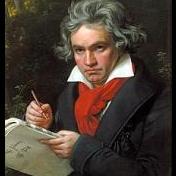Leaderboard
Popular Content
Showing content with the highest reputation on 10/10/2020 in all areas
-
Good evening everyone! I'm excited to present a new piece I have been working on for the last month or so: Scherzo for Orchestra. I deliberately wrote this fairly quickly, with the intent to write something fun, conventional, and maybe even a little whimsical. I'm interested in any and all constructive feedback. I had a few goals in mind as I composed this, feel free to critique my success or failure on these: Write something a little more informal and accessible, with catchy, memorable themes. Start with a very simple idea, and build the entire piece off of it. The four bar opening phrase in the 2nd violins popped into my head one day, so I tried to build the entire piece off of this motive and transformations of this motive. Practice having multiple contrapuntal lines. Some details on this are below. Write something that would work as a middle movement of a larger work, such as a symphony. Write something under 10 minutes, since I might decide to enter it into a competition and a lot of competitions have a 10 minute time limit. The piece is loosely structured in a three-part rondo form (ABACABA). (0:00 - 1:32) - A Theme - A very quick staccato theme in C# minor. I based this on the idea of a fugue, with each voice entering at different scale degrees, before they all come together to cadence. I'm sure I broke a few rules on the counterpoint, but it got the job done. The section ends on the V (G# minor) (1:32 - 2:21) - B Theme - A soaring theme in E major, then restated in Db major. Here I tried to have descending chromatic lines to complement the ascending melody. (2:21 - 3:04) - A Theme - Restatement of the second half of the A Theme, this time ending on I (C# minor) (3:04 - 6:31) - C Theme - A waltz in D major that begins very timid, gradually gains confidence, and goes out with a bang. (6:31 - 8:01) - A Theme - Restatement of the A Theme, this time in D minor, with the orchestration modified slightly. I threw in a couple unprepared modulations up a half step, to Eb minor and E minor. As a result I may have broken a "rule" here since I ended the section on B minor (which is not the V of D minor, the key I eventually return to). (8:01 - 8:49) - B Theme - Restatement of the B Theme, this time in Db major and Bb major. (8:49 - 9:37) - A Theme - The second half of the A Theme again, eventually returning to D minor to end the piece. As usual, I have an onslaught of questions I would like specific feedback on. Feel free to answer as many or as few as you wish: What effect does the music have on you? Does in conjure up an image? Or an emotional feeling? Does it tell you a story? This can be the piece as a whole, or a specific part or parts. What was your favorite part? What was your least favorite part? Do you have any comments or critiques on technique, e.g. harmony, melody writing, counterpoint, orchestration, voice-leading, etc.? How do you feel about the overall form? Is it effective? Do any of the parts seem impractical to you? It's a pretty fast piece with a lot of technique, so I'm curious if some of the parts are impractical. I don't mind them being difficult, I would only be concerned if they are borderline impossible. Do you have any comments of the quality of the performance in the audio file? I really want this to be a decent representation of how the piece would sound if it were performed live, since it is unlikely it ever will be. Feel free to put your "conductor hat" on and critique the "orchestra". I have included a score and welcome any constructive feedback on its presentation. And if you're like me it's a lot more fun to follow along with the score. Are there any composers this reminds you of, that I might enjoy listening to? Sound libraries: Spitfire Symphonic Orchestra and Spitfire Percussion VSL Trumpet (only for some of the lyrical trumpet melodies) VSL Violins (only to layer with the violins in Spitfire) Thanks for listening, I hope you enjoy! If you liked something I did and want me to explain how I did it, feel free to ask as well. -gmm2 points
-
I know more. Here are the other ones I know that you haven't mentioned: Ctrl + Up or Down -> Moving notes up or down an octave Alt + Number -> Add an interval above a note(so for example Alt + 6 would add a sixth above the note) Ctrl + Shift + Delete -> Reset rests in the measure to default Ctrl + Delete -> Remove measures Shift + S -> Stacatto S alone -> Slur Shift + Left or Right -> Extend slurs to following notes(or contract a slur if you find out later the slur is too long(Shift + Left contracts, Shift + Right extends) Shift + V -> Accent Ctrl + G -> Add Figured Bass Ctrl + E -> Add Expression text(so like expressivo or subito piano or any other expressive marking that's italicized in music) Alt + Shift + B -> Add extra measures Ctrl + Alt + Number from 1 to 4 -> Change voice(so like if you have 2 different melodic lines on the same staff for instance, this is useful)1 point
-
Take a walk in the woods and write from the heart. Use your theory knowledge to polish it with craftsmanship.1 point
-
My thoughts are: There's an infinite number of possible melodies because: There are 12 notes in standard tuning, 24 in Quarter-Tone tuning, some cultures use a more pentatonic tuning, but no matter how many notes there are, there is a finite number of arrangements sans repetitions. However repetitions are extremely common and virtually everywhere, both rearticulations and back and forth motions, Examples of rearticulation: Anything by Beethoven pretty much, Impromptu in Ab Op. 142 No.2 Schubert(both bass and treble rearticulations here), and hundreds more, Examples of back and forth motion: Virtually every piece written between the Renaissance and Stravinsky and even a lot beyond that There's more to melody than just note arranging too, even in the least structured melodies, rhythm plays a big role. And there are a lot more note values than most people realize. From Renaissance to Romantic you have these basic note values: 256th, 128th, 64th(I've seen notes that short in Bach's Toccata and Fugue in D minor for instance, right at the beginning of the Tocatta), 32nd, 16th, 8th, quarter, half, whole, double whole, and Longa(4 whole notes) + most of the possible dotted forms + even more of the triplet forms and so on. You can always do an octave transformation of any melody + Inversion, Retrograde, Retrograde Inversion, Augmentation, Diminution, and Stretto And lastly, all melodies have structure to some degree. Whether that's just tension and release points or whether it's whole phrase repetitions, there is structure. Whether all of the melody can be boiled down to 1-3 motifs and their transformations or not, there is structure. But structure doesn't limit us to a finite number of melodies Even in pieces that are literally just repeated chords(Chopin's C minor Prelude for instance) there is a melody and there always will be. Moonlight Sonata First Movement is another piece that I've heard of being referred to as no melody because there is so much harmony and what melody there is fits right in. So? The sheer abundance of harmony(chords, arpeggios, Alberti Bass, whatever) does not preclude the presence of melody. And both the Moonlight Sonata First Movement and the Chopin C minor Prelude show that a piece made entirely out of harmony still has a melody within the chords. Chordal melody in general is quite common, especially in the Classical and Romantic eras. I generally just improvise the melody on the spot. If there is a countermelody, I do the same for it and then listen. They generally turn out very good, complementing each other, when there are only 2 melodic lines anyway, with 3 it gets exponentially harder to get both independence of lines AND dissonance that isn't out of place, especially when the melodic lines tend to be within an octave of each other, which mine do with 3 lines and even more with 4 lines, have the average max distance of 1 octave between a pair of inner voices or a pair of an outer and inner voice, usually much closer to a third for the inner voice pair.1 point
-
Congrats on another superbly crafted piece. You continue to demonstrate your talented skill as a composer with each piece I've heard from you. I also really enjoyed sifting through the comments and seeing some of my questions answered with your responses to others; they're always well detailed, clear and concise. You not only exemplify your artistry with your music, but also with your ability to teach others what you were going for with an easily digestible explanation. You remind me of another member here (maybe he's gone now?), Austenite. You seem to have embodied a romantic-era style that is truly your own. The orchestra is used very maturely as you give many instruments their own time to shine, and the overall color throughout was a treat. I'd say one of your biggest strengths is how well you orchestrate. Your chords sound bold and full when you want them to, the crescendos across the different sections build into these great dramatic moments and were some of my favorite parts. The dynamics are extremely smooth, done with a great deal of finesse. You've absolutely captured the atmosphere of a scherzo with this piece. The A section gave off a Beethoven 9th scherzo vibe. Loved it. I'm a sucker for rhythmic motifs being the cornerstone to a piece (or section). I thought the B section was really cool too. The chromatic lines in the melody and harmony balanced really well, and gave this the contrast it needed. You've shown from your other comments how you constructed the B section which I appreciate. I'm kind of torn on the C section however, and it's possible you could even scrap it if the intention is for this to be a middle movement of a larger work. For one, I think the transition was a bit sudden. I like the horn transition, but maybe it could carry on with the ta-ti-ti-ta rhythm a bit for continuity? And while we're on that subject, I heard a few other spots that I think could have benefited from that as well, because the piece sometimes sounded a bit disjunctive. During the B section, I thought it would be could to have a low pedal tone playing that rhythm beneath the gorgeous chromatic textures. Or in the C section, with the opening statement of the melody, I could hear it echoing after the phrases, maybe giving a comedic effect too. You do a really good job of "hiding" your themes in other sections, and manipulating them for more thematic material, but sometimes I think if you used them more brashly and obvious to the listener, it would create a smoother flow, where the sections are different but easy to hear and see their relationship together throughout the piece. This may be just me, and I'm a low-art musician at heart, but I always strive for the perfect balance of cerebral craftsmanship/language with the idea that music is communication, and I don't want anyone to hear my music without being able to take something away from it. Not saying that the language or tactics you use is indecipherable, but keep the catchy or identifiable moments at the forefront, and use them as glue when putting say a subtle but then bombastic waltz with a vigorous flurry of strings with a cascade of chromaticism. If you were going for a statement in how romantic-era music could be composed today, well done. But I'm very curious with how you view your musical voice and what you wish to accomplish with your music. For instance, percussion in that era is relatively primitive sounding to me because we live in an age where rhythm is so dominant and explored. The percussion seemed mostly limited to the C section. I think with a more liberal usage of it in the other sections, your music could sound romantic inspired but very modern. Overall, I'll continue to be a gmm fanboy after hearing this. I listened to this a few hours ago, and gave it multiple listens since then to make sure I really knew what I wanted to say. The A theme is really catchy, it was stuck in my head as I ran a bunch of errands today. I love your style man, I'm excited to hear how you continue to evolve!1 point
-
1 point
-
The F7 kinda functions as a tritone substitution as (after a brief detour) it eventually leads back to the Esus2. If you respell the Ab chord as a G# major it becomes more clear that it functions as a III in E major. Resolving to an E minor chord from there is nice and smooth since the G# would go down to G, the B# to B and the leading tone (D#) would resolve as expected to E. You resolve it to an E7sus2 which works as well and the D is just a nice color tone (which in a tonic minor chord would be quite foreign in the music of the classical and pre-classical eras). This progression does make sense to me. Nice job! (-:1 point
-
Hi PaperComposer, thanks for the nice and useful comment. To be honest, I was playing on the piano around the E- chord, added the F7 | Bb progression, then I just thought the Ab and Esus2 were nice chords to finish up. Since you noticed that there is a tritone substitution, do you mind helping me out a bit to understand what is going on here with the harmonic functions? My interpreation is that, while the main key is Emin, there seems to be a temporary modulation to Bb major through the F7 tritone substitution (sub B7), which resolves to Bb. Ab is still in Bb major, and then suddenly goes back to. I don't see a clear link between Ab and Esus2, but it sounds ok . Does it make sense to you?1 point
-
I wouldn't say it was planned all the way through but I was thinking of the planet earth bit where the little birds have to jump out of a high nest and bounce on the ground (and are okay) and just what it sounded like to me. I don't usually start with any plan, I do it and then I start to see the meaning behind it, and then the rest of my piece is the rest of the story where now I have creative control. What do you mean by "through-composed" jw?1 point
-
Hi all, After my secondary school I want to study either Classical Saxophone or Composition. When I am chatting with Composition professors, it seems to me that they prefer composing on paper and then they notate in a notation program. I have tried it several times to compose on paper, but I find it really hard. Not because I don't know what the music will really sound like, but because I make so many notation mistakes. Actually, when writing music on paper, my scores look like Beethoven's (see picture) and I cannot even read in myself. . . My question: ''Do you compose your music first on paper and then in a notation program? Or do you directly notate in a program, such as Sibelius or MuseScore? Why?'' I think the ''Why'' is the most important part of the question. Please let me know your opinions, experiences etc. Kind regards, Maarten1 point



.thumb.png.8b5b433a341551e913a34392660bc95b.png)

